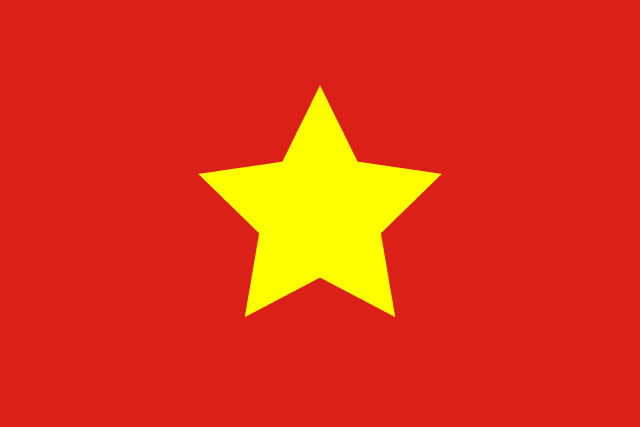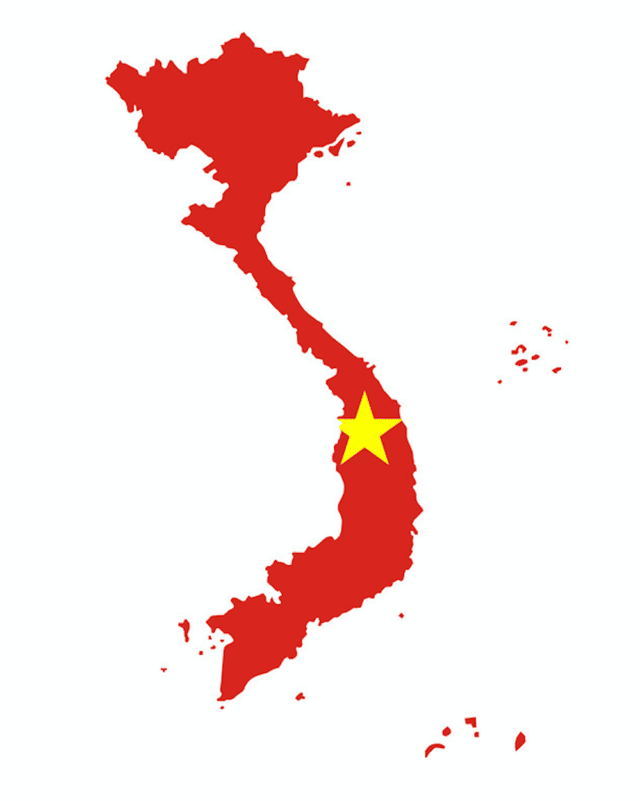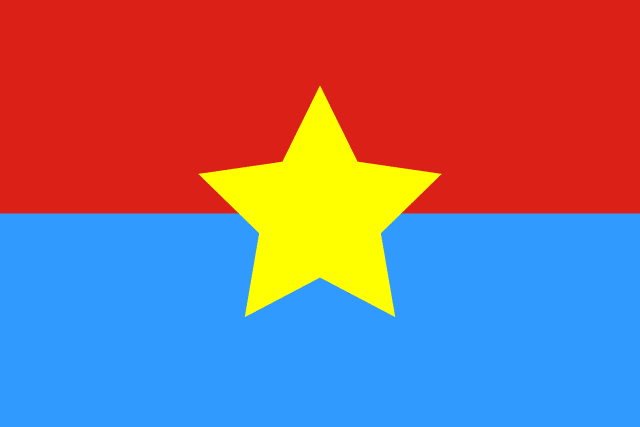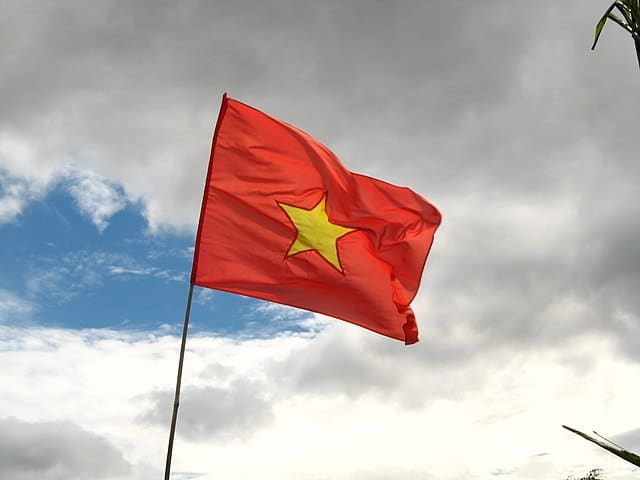The flag of Vietnam, also known as the “flag of the fatherland,” was created in 1940 and flown during a rebellion against the French in southern Vietnam that same year. Its official name is the National Flag of the Socialist Republic of Vietnam. Still, it is also known as the “red flag with a golden star.”
Since you came across this article, you must be curious about its meaning, symbolism, and significance. All those things are explored in the article below.
Characteristics Of Vietnam
Before learning more about the Vietnam flag, it is important to also look at the country’s demographic and geographical background. Vietnam is a long, thin country with an s-shaped outline. It is situated in Southeast Asia, not far from the easternmost tip of the Indochina peninsula. Its western boundaries are shared with Laos and Cambodia, while its northern neighbor is China. The South China Sea is to the east and south. The majority of Vietnam’s western side is covered in the Annam Cordillera mountains, while its eastern side is dominated by a 1,600 miles (1,600km) long coastline.
The Mekong in the south and the Red in the north are two of Vietnam’s greatest rivers, and both flow into the South China Sea, where they meet in vast deltas of swampland. The majority of the population lives in these regions, which also offer good ground for the cultivation of several other crops like rice.
The vast majority of Vietnamese people live in rural areas, primarily in the north and south river delta regions. However, recently, individuals have been relocating to the major cities of Hanoi and Ho Chi Minh City.
Vietnamese cuisine combines elements of Chinese and Thai cuisine and includes seafood as well as locally grown fruits and vegetables. Vietnam is a communist nation without a designated official religion. However, people are allowed to practice their religion as they like, and many adhere to the so-called “Three Teachings” of Confucianism, Taoism, and Buddhism.
Vietnam is in the UTC+7 time zone. Therefore, the time in Vietnam is 7 hours ahead of UTC.

History Of Vietnam
The star on the Vietnam flag and the golden and red colors all reflect the country’s past. Around 5,000 years ago, the Red River Valley saw the emergence of the first civilizations in Vietnam. These northern tribes thrived up until 207 B.C. when a Chinese ruler invaded and founded the Nam Viet kingdom there.
Nam Viet was included in the Chinese empire in 111 B.C., and the Chinese governed the region until Ngo Quyen, a Vietnamese leader, launched a revolution that drove the Chinese out in A.D. 939. Later dynasties changed the name of the nation to Dai Viet, which eventually expanded southward. Dai Viet was split between two warring kingdoms by the middle of the fifteenth century: the Trinh in the north and the Nguyen in the south.
A Nguyen lord overcame the Trinh in 1802, with the assistance of the French, and the nation was given the new name Vietnam. However, France had seized control of Vietnam by 1890.
Following a brief Japanese occupation during World War II, Ho Chi Minh, the head of the Vietnamese Communist Party, proclaimed Vietnam’s independence when the war ended with Japan’s defeat in 1945.
War broke out with the Viet Minh, a communist Vietnamese group, as a result of French attempts to reclaim Vietnam. After the nation was split into communist North Vietnam and non-communist South Vietnam in 1954, the fighting came to a halt. The Viet Cong, a group of communist guerrillas in the south, started up in 1957. Following the start of the North and South conflict, the United States, Russia, and China quickly entered the fray. The conflict persisted until 1975 when the communists invaded the south and seized Saigon as its capital.

History of Vietnam Flag
With a rich history and relevance to the country’s constitution, the Vietnam flag has grown to symbolize national pride for so many Vietnamese today. On November 30, 1995, the National Flag was formally adopted. It has a solid red background with a big yellow five-pointed star in the middle. Like the flags of every growing postcolonial nation, the Vietnam flag symbolizes the revolution and fight of millions of people for their homeland.
The Vietnam flag that is now recognized by the entire globe signifies a free and united Vietnam. It originally emerged on November 23, 1940, in South Vietnam. Since southern Vietnam was a French colony at the time, it was adopted as a local revolutionary banner against French colonial control. The flag was created by Nguyen Huu Tien, a leader of the revolt who was eventually detained. On August 28, 1941, he was put to death by the French government since the first revolt was a failure.
Later in 1941, the Vietnam flag was flown during a gathering when it was adopted as the symbol of the Viet Minh forces, which Ho Chi Minh founded and organized in order to aid the people of Vietnam and resist the atrocious French colonists. The red flag with a star was officially designated as the national flag of the entire revolutionary period on August 17, 1945, at a session of the National Assembly.
Once the Viet Minh reached Hanoi and Vietnam was declared independent, the red flag became the flag of North Vietnam as World War II came to an end and the Japanese occupation collapsed. In September 1945, it received the name Democratic Republic of Vietnam.
Things changed in South Vietnam in the meantime. In October, French forces once again invaded the southern government, and the French administration persisted. The south, officially known as the Republic of Vietnam, was in power and had its own flag. Their banner, which was modeled after other revolutionary flags in Vietnam’s history, had a yellow background and three red horizontal stripes.
Vietnam’s democratic republic assumed national leadership later in 1960. Instead of the Republic of Vietnam, a new government was founded in the south by the National Liberation Forces of Vietnam. They displayed a second revolutionary flag, which was a hybrid of red and blue flags with a yellow star in the middle.
The South Vietnamese flag vanished when the communists gained prominence and the American and South Vietnamese forces were routed in the Vietnam War in 1975. The Socialist Republic of Vietnam was established on July 2, 1976, and the red flag was adopted in the south. It is now being raised across the country.

Symbolism and Meaning of the Vietnam Flag
When the original plain red flag came to represent left-wing politics against the French and the communist country of Vietnam, the vivid red flag was born. Since then, the color red has evolved into the nation’s main emblem. In addition to having authentic and historical Vietnam traits imprinted in it, the current red Vietnam flag has its symbolism steeped in the country’s history of resistance against the ruling classes of the French colonial administration.
The flag is rectangular in shape, with a five-pointed yellow star in the middle of a vivid red backdrop. The reasons why the colors red and yellow came to represent the heart of the nation are special. Nguyen Huu Tien, who created the flag, interprets the color red as a representation of blood.
It represents the sacrifice of the populace and the fight for the country’s freedom. “The hue of our race’s skin” is symbolized by the yellow star. The star’s legs are distinguished by glorifying the five main social classes: farmers, business, people, laborers, soldiers, and intellectuals.
Although they appear to be relatively simple, the Vietnam flags have always had a long history of the battle. It is one of the most basic national flags in existence, yet the red backdrop and the gold star may convey a message that no other design can. The Vietnam flag’s design also has another important meaning: it pays homage to the warriors who gave their lives fighting for their country’s peace and integrity.
Every Vietnamese individual has confidence, trust, and pride in the historical Vietnam flag that serves as the country’s current official emblem. Vietnamese people proudly fly their red-backed national flag throughout every special festival to honor the bloodshed and the tears that flooded everyone’s eyes.
In Hanoi, the nation’s capital, there is a strong tradition regarding the Vietnam flag. The daily ceremony of hoisting the flag has become a practice. It has also developed into a popular tourist spot. From 6 a.m. until 9 a.m., many people go to the area to see the ritual.

Bottom Line
There is still a lot of uncertainty about the creator of the Vietnam flag, and there are few leads that may lead to an explanation. Some people say that it was made by a revolutionist by the name of Nguyen Huu Tien, while others assume that Le Hong Phong and Nguyen Thi Minh Khai, two well-known members of the French resistance in the 1940s, were responsible.
No matter who was the author of the design, one thing is clear: the Vietnam flag design has a special meaning and significance for the people of this country.